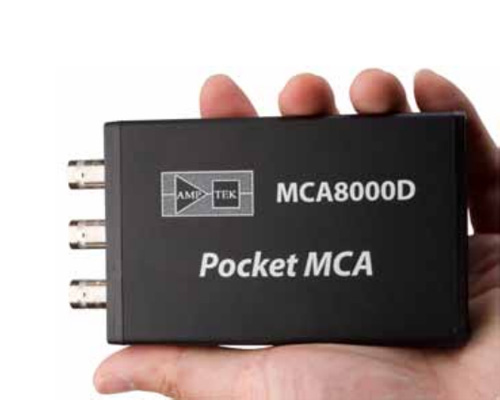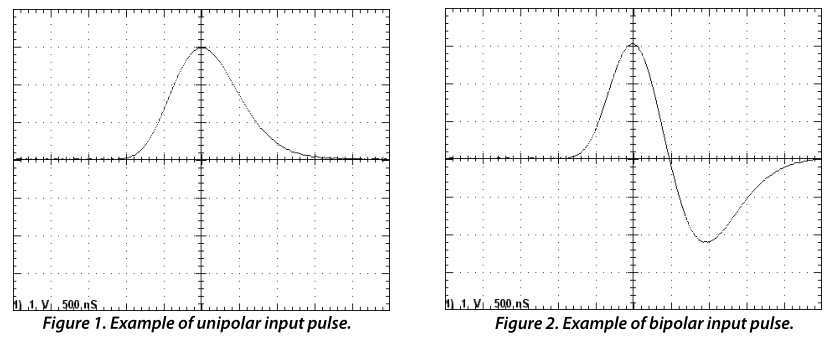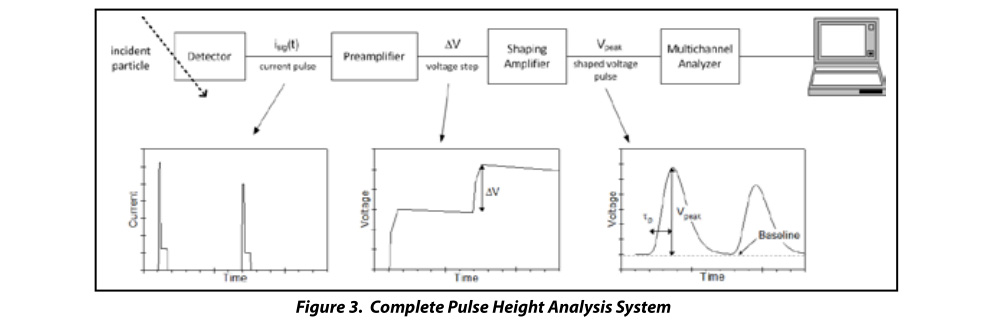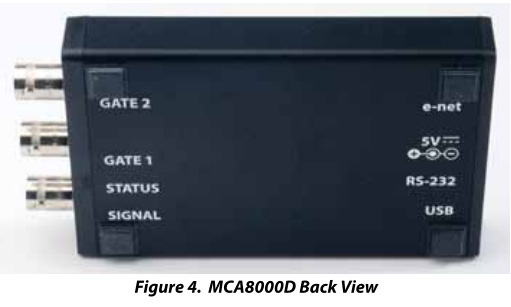

The Amptek MCA8000D is a full-featured digital multichannel analyzer intended to be used with a wide variety of detector systems.
Features
? Compatible with traditional analog pulse shaping? Optional PA Package for airborne and suspended particle detection applications
Amptek’s MCA8000D is a state-of-the-art, compact, high performance,digital MultiChannel Analyzer (MCA). It replaces the MCA8000A, providing the same functionality with reduced dead time, modern communications interfaces (USB, RS-232, and Ethernet), and much higher data transfer rates.Because it does not implement digital pulse shaping, it is compatible with
analog pulse shaping systems.
Superior performance is obtained from a high speed ADC (a 100 MHz 16 bit ADC) and sophisticated digital logic. The MCA8000D digitizes the input signal (the output of an analog shaping amplifier) to measure the pulse height and obtain the pulse height spectrum. The high speed ADC, with a 10 ns conversion time, reduces dead time thus increasing throughput. The
digital circuitry yields high accuracy and stability.
The MCA8000D includes three interfaces, USB (USB 2.0 full speed),RS-232 (up to 115 kB), and Ethernet (10base-T). It uses the same DPPMCA software package as Amptek’s digital signal processors, including the DP5,PX5, and X-123. The MCA8000D can be powered over USB or with an external AC/DC power supply.
Compromising nothing in performance, the MCA8000D is a low power,light weight instrument which is exceptionally versatile and easy to use.
Examples of unipolar (top) and bipolar (bottom) input pulse shapes suitable for the MCA8000D

SPECIFICATIONS
| PerforManCe C haraCteristiCs | |
| Pulse-Height Digitizer | High speed 100 MHz, 16 bit ADC with digital pulse height measurement. Input ranges of 0 to 1V or 0 to 10V (software selectable) Number of channels commandable to 256, 512, 1k, 2k, 4k,or 8k channels |
| Pulse Processing Times | Pulse peaking time ≥ 500 ns to meet specifications. |
| Peak Detection Modes (SeeFigure 3) | First Peak AfterThreshold (V1):Standard to nuclear instrumentation MCAs. |
| Absolute Peak Above Threshold (V2):Typically used in airborne particle sizing analyzers, in environmental air monitoring systems and in aerosol research. | |
| Acquisition Modes | MCA and MCS (multichannel scaling) down to 10 ms/channel. |
| Differential Nonlinearity | <±0.6% from 15 mV to full scale. |
| Integral Nonlinearity | <±0.02% over full scale. |
| Gain Stability | Gain ±10 ppm/oC.; Zero drift ±10 ppm/oC. (typical) |
| Low Level Discriminator | Software selectable threshold, in increments of one channel |
| Counts per Channel | Maximum = 16.7 x 10 6 counts (3 bytes). |
| Real and Live Timers | Data acquisition real or live time preset in multiples of one second. Maximum preset time 16777215 (224 - 1) seconds.Shorter or non-integer accumulation times can be achieved by gating the input signal with Gate 1 or Gate 2. Real and Live Time: 4,294,967.29 s (0.01 s precision); 999,999.999 s (0.001 s precision). Acquisition Time: 99,999,999.9 s (0.1 s precision) Preset Counts: 4,294,967,295 (232 -1) in channel or ROI |
| Interface | RS232: 115 Kbaud. USB: Standard 2.0 full speed (12 Mbps). Ethernet: Standard 10base-T. |
| Operating Temperature | -20oC to +60oC. |
| exterior C ontrols and i ndiCators | |
| Status Light | Steady red light: power is ON and no data acquisition in progress. Flashing red light: data acquisition mode. |
| Power | |
| Operating Power | 2 W. |
| Power Sources | Power: +5V at 0.4A Input range: +4V to +5.5V (0.5 to 0.4A typical) Power source: USB power or AC/DC adapter (supplied) |
| ConneCtions | |
| Input | The analog input accepts positive unipolar or bipolar semigaussian type pulses of shaping time constants ≥200 ns or peaking time ≥500 ns. See Figures 1 and 2. The dynamic range is 0 to +1 V or 0 to +10 V, software selectable.Minimum pulse height is 5 mV. Input impedance is 1 k? or 100 k? (options at purchase). The input has overload protection up to ±20 V. The DC level of the input signal must be zero. |
| Gates | The MCA-8000D has two logic gates. GATE1 is generally used to synchronize acquisition with external hardware while GATE2 is generally used for pileup rejection. Each gate can be commanded to ACTIVE HIGH, ACTIVE LOW, or DISABLED. The active state of each GATE input is evaluated at the time the peak of the input analog pulse is detected. To enable the Gate input in the DPPMCA software, on the ‘MCA’ tab,select ‘Gate Control’ as HIGH or LOW. HIGH means when the GATE1 input is logic high, pulses are accepted (gated off while low.) LOW means pulses are accepted while the GATE1 input is logic low TTL-compatible and 3.3V CMOS: Input High: 2 V min Input Low: 0.8 V max Absolute max: 6 V Absolute min: -2 V Input has 50 ohms in series with TISN74LVC1T45 transceiver (powered from 3.3 V). The device prefers rise/fall times of 30 ns or faster but should work acceptably with slower edges. |
| Interface(I/O) | USB: Standard USB Mini-B jack. Ethernet: Standard Ethernet jack. RS232: Standard 2.5 mm stereo audio jack. Power Center positive 5.5 mm x 2.1 mm plug. |
| MeChaniCal | |
| Weight | <165 g |
| Dimensions | 5 x 2.8 x 0.8 in (125 x 71 x 20 mm). |

OPERATING NOTES
Amptek’s MCA8000D is one component in a complete pulse height analysis system. Figure 3 illustrates a typical system: the radiation detector is connected to a charge sensitive preamplifier, which is connected to a shaping amplifier. The output of the shaping amplifier is a pulse with peak amplitude proportional to the energy deposited in the detector. The MCA measures the amplitude of the peak and produces a histogram representing the pulse height spectrum. This histogram, an integer array of the number of events in each pulse height channel, is the primary output of the MCA and is transferred to a computer over USB, Ethernet, or RS232 interfaces.
Amptek’s MCA8000D does not include pulse shaping circuitry but only the MCA circuitry. The MCA8000D must be preceded by pulse shaping circuits. Figures 1 and 2 show typical pulse shapes input to the MCA8000D. Amptek, Inc has other products (including the DP5, DP5G, PX5, and PX5-HPGe) which include both pulse shaping and MCA circuitry. These use digital pulse processing for the very best performance. Please contact Amptek, Inc for information on these integrated systems. Note that some manufacturers use the term “MCA” for modules which include both the pulse shaping and the traditional MCA functions.
Amptek’s MCA8000D is most often used to measure the energy spectrum from a radiation detector, where the pulse height is proportional to energy but can be used in other applications. For example, instruments used to monitor cleanrooms produce an output pulse proportional to the size of the particle, so the MCA8000D is used to measure the particle size spectrum. Some radiation detection systems used in timing produce a pulse height proportional to the time between events (using a time to amplitude converter), so the MCA8000D yields a timing spectrum.

SOFTWARE
The MCA8000D can be controlled by the Amptek DPPMCA display and acquisition software. This software sets the configuration (number of channels, input range, etc), can start and stop acquisitions, can display the spectra, and supports basic analysis functions such as defining regions of interest (ROI), performing calibrations, peak searching, and so on. Data are saved in an ASCII file format. The DPPMCA software is also used with Amptek’s digital pulse processors, including the DP5, Gamma-Rad5, PX5, etc.
The MCA8000D comes with a complete Software Development Kit (SDK). The user can use this platform to easily develop software to control the MCA for custom applications or to interface it to a larger system. Examples are provided in VB, VC++, etc. The standard DPPMCA software runs only on Windows operating systems but users can develop interface software running on Linux or other operating systems using documentation and sample code which are provided.
ADVANCED ANALYSES
The pulse height spectrum is the primary output from the MCA8000D. It can also be used in a “multichannel scaling” mode to record count rate vs time (down to 10 ms/channel).
OPTION PA FOR PARTICLE COUNTING
The Option PA package has been developed to facilitate the use of the MCA8000D for particle counting in airborne (Size Calibration) and liquid suspended 1 (Number Calibration) particle applications. The unit is calibrated and certified traceable to the National Institute of
Standards and Technology (NIST).
The Option PA package is capable of detecting pulses from 5 mV to 10 V. The MCA8000D is typically connected to the output of a particle sensor. It detects and displays a spectrum of pulse heights allowing the user to determine if a given particle size is producing
the correct voltage.
The software included with the MCA provides information on the peak center (centroid and mean calculation) making it easy to determine if the peak is in the correct position. The supplied calibration curves convert the MCA channel scale to a mV scale. The calibration curves can be set to load automatically when the software opens.
1 Sommer, H.T. “IMPLEMENTING PARTICLE COUNTER CALIBRATION PER ISO 11171-1999.”; TEAM Service, Inc., P.O. Box 220, Merlin, OR 97532, (541)476-4744, HolgerTSo@aol.com; Copyright Society of Automotive Engineers


Frequently Asked Questions
How does the MCA8000D differ from the previous MCA8000A?
1) It now supports USB, Ethernet, and RS232 interfaces with much faster data transfers. It makes operation with modern computers very easy.
2) It uses the DPPMCA acquisition software, a new version of the older ADMCA software.
3) It can be powered by USB or an external plug. It does not contain a battery.
4) It has 8k data channels and is specified for pulse risetimes >0.5 us.
5) It is an all digital solution, with a fast ADC and digital peak detection.
6) It is smaller and lighter.
MCA8000D Ordering Information
MCA8000D Basic Package - for Nuclear Instrumentation MCA8000D PA Package - for Airborne Particle Sizing
? MCA8000D
? MCA8000D Basic Package, modified for 100 k? input impedance
? One AC adapter for MCA8000D
? NIST traceable calibration
? One BNC signal cable (1 meter length)
? Certificate of Calibration
? One Mini-USB cable
? DPPMCA Display Software installation disk
XRF-FP Quantitative Analysis Software - Optional
Features
Fundamental Parameter (FP) Calculations Analysis with or without standards General bulk and thin-film analysis Analyze up to 40 elements Automode for continuous or repeated analyses
Spectrum Processing
? Spectrum calibration
? Background removal and blank subtraction
? Escape peak and sum peak removal
? Smoothing
? Deconvolution: Intensity extraction

 微信二維碼
微信二維碼